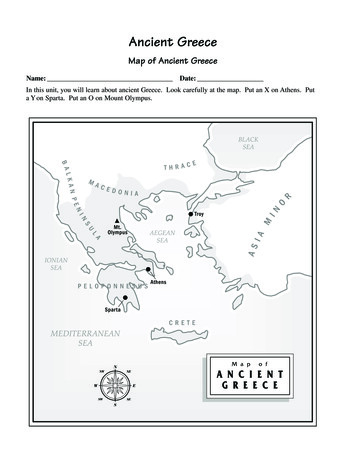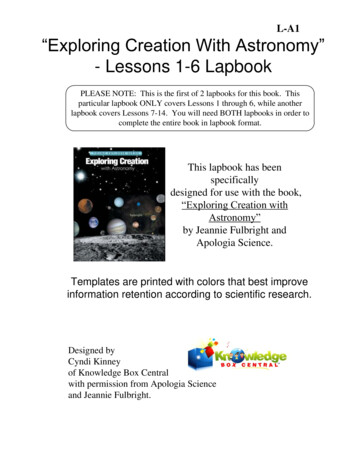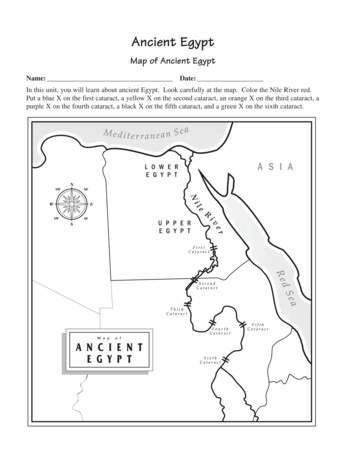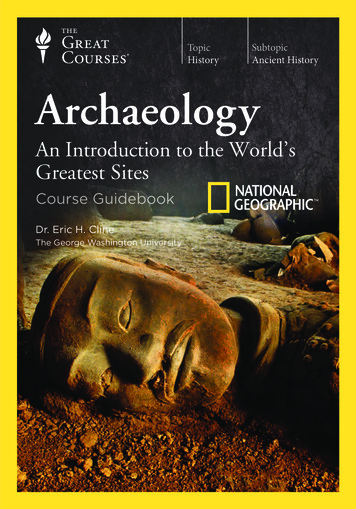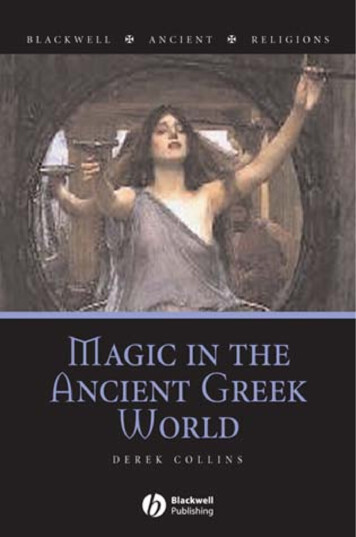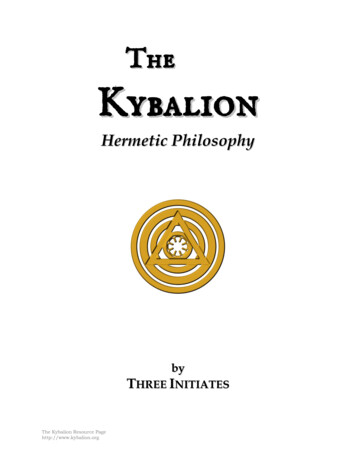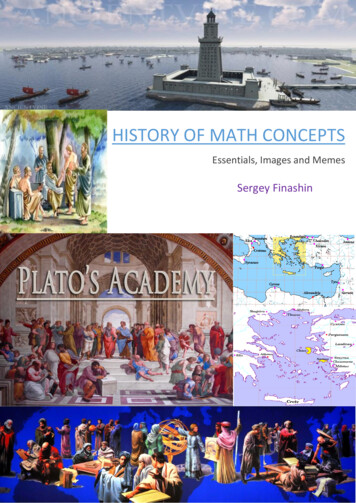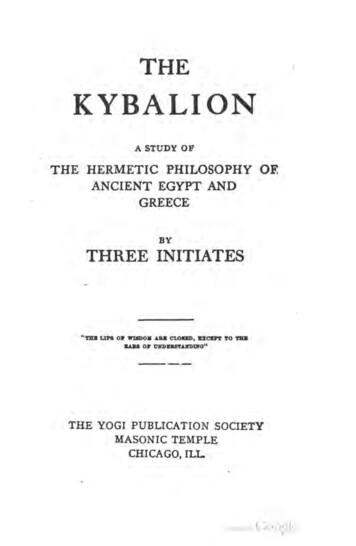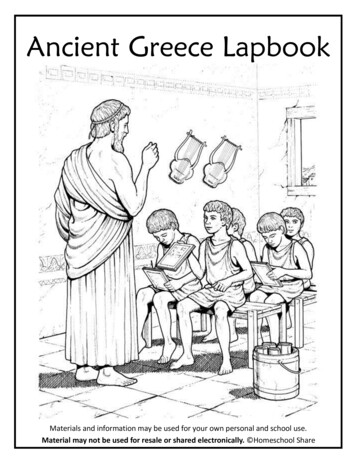
Transcription
Ancient Greece LapbookMaterials and information may be used for your own personal and school use.Material may not be used for resale or shared electronically. Homeschool Share
Ancient Greecestudy by Jodi SmallGreeceThe small country of Greece is located along the coast of the MediterraneanSea. There are mountains and islands. It is a hot, dry climate most of theyear. Olive trees grow well in Greece's dry, rocky soil. They are very strong andcan stand up under heavy wind. Greeks believed olive trees were symbols ofstrength and peace. Greeks used olive oil to clean their skin and they used it intheir hair.Lapbook: About Greece tab bookAncient GreeceThe first settlers of Greece were shepherds, farmers and fishermen. Greeksettlements competed for the best, most fertile land because there was so littleof it. The country was divided into city-states, which is a city that governs thecountryside around it. Greek people all worshipped the same gods, had thesame customs and were proud to be Greeks. Most cities were near the seabecause most travelling was done by boat. Since there were so many hills andmountains, travel on land was difficult and there were not many roads. Greekcities were protected by walls.Lapbook: Greek City-States wheel bookAthensThe city of Athens was one of the most powerful city-state. The name of Athens
came from the goddess of wisdom, Athena. Athens had a democraticgovernment, meaning the people ran the government. Voting was veryimportant by male citizens, age 20 or older. Citizens were those people whowere actually born in Athens. Women and slaves could not vote. Atheniansloved beauty and learning. Citizens created beautiful art, wrote poetry andplays, and studied math and science.The walled part of the city of Athens was the Acropolis. The Acropolis was ontop a hill overlooking the city and the people lived in apartments and housesbelow. The agora was the marketplace where food, crafts and household itemswere sold. Men did most of the shopping in Greece.SpartaThe city of Sparta, in southern Greece, was ruled by 2 kings. Spartans werewarriors and trained much for war. Sparta and Athens often fought eachother. Boys learned to be soldiers at age seven at school. The girl's main jobwas to grow up, marry, and produce strong Spartan boys.Lapbook: Athens-Sparta Venn diagram bookTrojan WarBecause Greece was so hilly and dry, they were unable to grow enough wheat,so Greeks had to sail across the Aegean Sea to Asia and buy wheat. The city ofTroy was located at the entrance of the channel connecting the Aegean Sea tothe Black Sea. Greeks had to cross this channel to get to Asia and the king ofTroy, King Priam wanted the Greeks to pay a toll to pass through. The Greekswere angry that they had to pay a toll to pass.Lapbook: Where is Troy?The king of Sparta, King Menelaus’s wife was captured by the Trojans, thepeople of Troy. King Menelaus planned to go to Troy to get his wife, but heneeded help. His brother was King Agamemnon, the king of Mycenae. The twoGreek armies decided to go to war with the city of Troy. Odysseus, the son ofthe King of Ithaca, joined the armies to attack.
The city of Troy was surrounded by strong walls. The Trojan army came out tofight in the rocky field between their city and the sea. After ten years of fightingand much death, no one could win the war. Odysseus decided the only way towin was to get inside the city.The Greeks used lumber to build a huge wooden horse that was hollow with asmall trap door on the side. When the horse was finished, many soldiers wereput inside the horse. The rest of the soldiers got in their boats with everythingfrom their camp and left to go back to Greece. Only one soldier, Sinon, stayedbehind hiding in the bushes. The lookout for the city of Troy announced theGreeks had left. The people of Troy went outside their city and found the hugewooden horse.The Trojans examined the horse and were suspicious. Then Sinon is foundhiding and is brought before the King. Sinon tells the Trojans that the horse is agift from Athena. The King did not want to destroy the horse and make Athenaangry, so they put ropes around the horse’s neck and pulled it into the city. TheTrojans had to tear down part of the gate to the city to get the horse inside.Once the horse got to the temple of Athena, they held a festival. After thepeople in the city of Troy went to sleep, the Greeks came out of the body of thehorse. They killed the lookout guards and lit a torch on top the wall to signal theGreek ships to return. The Greeks from the ships entered the city through thehole in the wall and they all set fires to Troy. Some Trojans escape, but manydied in the fires. The Greeks won the war.Lapbook: Trojan Horse mini bookMany years later, the poet Homer writes poem about Odysseus and the otherheroes of the Trojan war in his poem the Iliad.Gods and GoddessesGreek gods looked like humans but had special powers. Greeks told manystories about the gods they worshipped, called myths. (A myth is a story that isnot true.) Greeks believed their gods lived on top of the mountain, Olympus,and rested and ate ambrosia all day. Greeks prayed to these gods to please
them. They had altars in their homes and gave them gifts. They thought theywould be punished if the gods were unhappy.Lapbook: A Myth Is . . .Greeks built large temples for their gods. Inside the temples was a statue of thegod. Statues were tall and covered with gold and ivory.They also held festivals to honor their gods. Many traveled from far away tocome to these festivals. Greeks would bring food and gifts to give theirgods. Sporting events were included in these festivals along with music anddancing.-Zeus – ruler of the godsZeus was the god of the sky, clouds and rain. You didn’t want to make himmad. He would throw lightning down to earth. Greeks believed that when Zeuswas talking, the oak leaves rustled.-Hera – goddess of marriage and the wife of ZeusA myth about Hera is that she got very angry with Zeus for loving otherwomen. A girl named Echo was talking to Hera and distracted her from findingZeus with other women. Hera got very angry with Echo for keeping her fromcatching Zeus with other women so she cursed Echo from being able to speakon her own. Instead, Echo could only repeat the last word that someone said toher over and over again. That’s where our word 'echo' came from.-Poseidon – god of the seas and Zeus’s brotherPoseidon lived under the sea and used a trident, or spear, to hit the water whenhe was angry. This would cause earthquakes and storms. One myth says thatwhen the Greeks lost a war, Poseidon became so angry that he sent a hugestorm to wreck the ships the soldiers were using to return to Greece.-Aphrodite – goddess of love and beauty
Aphrodite was beautiful, flowers came up when she walked through fields andwaves laughed when she walked by. She was always shown with a smile on herface.-Athena – goddess of wisdom, the arts and war, also the daughter of ZeusAthena’s main job was to protect Athens from Poseidon, who wanted the cityfor himself. Athena also trained the first horses.-Phoebus Apollo , or just Apollo – god of the sun, healing, music and poetryand the son of ZeusApollo had golden hair and carried a silver bow. He raced his chariot across thesky and played music for the other gods on his lyre, a harp-like instrument.Lapbook: Greek Gods mini bookFlag Book InstructionsIn comparing the Greek gods to the Roman gods, they are basically the samegods with different names. Zeus/Jupiter, Aphrodite/Venus, Hera/Juno,Poseidon/Neptune.Greek lifeGreek houses were made of stone, clay or wood. The roofs were tile or reedsand the floors were dirt or stone. There were not many rooms and littlefurniture. They had wooden tables, chairs and couches. For storage, they usedbaskets or chests. There was a courtyard in the middle of the home where thefamily would gather, cook and eat their meals. Occasionally, there would be awell in the courtyard. Greek food consisted of bread, olive oil, goat cheese, figs,grapes, honey, fish and seafood.Greek people wore tunics, a piece of cloth wrapped around them. Men’s tunics,called chitons, came to the knee. Women’s tunics, called peplos, werelonger. They wore sandals, slippers or boots when they went out, otherwise,they were barefoot. Women wore jewelry and make-up. They would put whitepowder on their faces to look pale. They would put oil in their hair.
Schools were for only for boys. They started at age seven and learned to readand write. They studied poetry, music and sports. Girls stayed home andlearned to run the house. They learned to spin, weave, sew and cook. Rich girlswould learn to read and write at home. Fathers arranged marriages for theirdaughters, who would marry as young as 15 years old.Children played games similar to chess and checkers. They also played withdolls, clay animals, and hoops.Try this game – PentelithoiYou will need five small stones (or something similar). This game is a lotlike Jacks and was popular with women and girls.Take turns with a friend. With one had, toss five stones into the air. It’seasier if you don’t toss them high. Catch as many as you can on the back ofyour throwing hand. This takes practice. It helps to bend your fingers backand spread them out. If all the stones fall to the ground, your turn isover. If you catch them all, you win. If you catch one to four, leave them onthe back of your hand while you try to pick up the ones that fell. If you canpick them all up and not drop any, take another turn.Or try this game – Knucklebones (popular with boys)This game is similar to marbles.Draw a circle about two feet across. You can use chalk on a sidewalk or amarker on a piece of poster board. Gather one or two other friends toplay. Set two or more knucklebones (stones) inside the circle, keeping oneout for each player. Take turns trying to knock knucklebones out of thecircle by throwing your knucklebone at them. Pick up your knuckleboneafter each throw. If you knock one out, keep it till the end of the game andtake another turn. The game ends when all the knucklebones have beenknocked out. The winner is the one with the most knucklebones at theend.
Greeks had many different dances, some to honor their gods. They danced atweddings and funerals, at harvest time and after war.The gymnasium was like a park where Greeks played sports and exercised. Menand boys spent time there during the day.Men gave parties called symposia (symposium is the singular form) for menonly. Slave girls would meet the guests at the door and wash their feet. Guestsdrank wine, ate, talked and sometimes recited poetry and sang.Lapbook: What is a Symposium?, Greek LifeFamous GreeksSocratesSocrates was a philosopher. A philosopher is someone who loves learning andthey were often teachers. Socrates believed that a good person was a happyperson and that money is not enough to make someone happy.Lapbook: A Philosopher Is . . .PlatoPlato was a student under Socrates. He wrote things down that Socratessaid. He later became a philosopher himself and ran a school called theAcademy.HippocratesHippocrates was a Greek doctor who studied the human body and how itworked. He wrote an oath (a strong promise), called the Hippocratic oath today,where doctors promise to not do harm.PhidiasPhidias was the sculptor who created the statue of Zeus sitting on a throne. Thestatue was covered with ivory and gold. The statue was located in the temple ofZeus. The temple was destroyed by earthquakes and war.
Lapbook: Famous GreeksHomerHomer was a great poet, whom some say was blind. Greeks liked to recite hispoetry. He wrote one poem called The Iliad, which was about the war betweenthe Greeks and the Trojans. He also wrote The Odyssey, the adventures ofOdysseus.Lapbook: HomerOlder students may want to read the Iliad or the Odyssey. Here is an on-lineversion of the Illiad. Here is an on-line version of the Odyssey.If your student reads either of the poems and wants to write a summary, you canuse either of these pocketbooks:Lapbook: The Illiad, The OdysseyAlexander the GreatAlexander’s father was King Philip of Macedonia. Macedonia was a part ofGreece. They worshipped the same gods and spoke the same language. KingPhilip was preparing Greece to go to war with Persia when he wasmurdered. Alexander then became king at age 20. He had to prove himself aspowerful as his father.In 334 BC, Alexander invaded present day Turkey. He met up with King DariusIII, king of Persia in the Battle of Issus. The Macedonians were outnumbered, butAlexander’s army was stronger. Darius fled from this battle, but continued torule over the Mediterranean Sea. Alexander did not have a powerful fleet ofships. Alexander then planned to capture the ports. The port in the city of Tyredid not give up easily. They fought for over seven months before Alexandercaptured the city.In 332 BC, Alexander moved on to Egypt. The Egyptians were unhappy that theywere under Persian rule, so they welcomed Alexander and made him
pharaoh. Alexander made a port on the Mediterranean in Egypt and named itAlexandria.Meanwhile, Darius strengthened his army and planned for another battle, TheBattle of Gaugemela (modern day Iraq). Darius made some serious mistakes inhis attack plans and lost his soldiers confidence. King Darius was taken prisonerby his own men. The rest of the Persians surrendered to Alexander. Alexanderthen became ruler of the Persian Empire.Alexander began to wear Persian clothing and became friends with Persianpeople, which upset the Macedonians.In 326 BC, Alexander moved into India to grow his empire. The Greeks had noidea how large the country of India was, or what kind of people resided there,but Alexander forged ahead into the country. They went during the rainyseason and suffered much. They had to cross flooded rivers and the soldierswere very unhappy. They begged to go home. Alexander was told by Coenus,one of the soldiers, “The one thing a successful man should know is when tostop.” Alexander decided to turn around and go home, but instead of going theway they went in, Alexander wanted to explore the land around the IndianOcean. This is desert area, and many soldiers died from hunger and thirst.Back at home, Alexander planned to conquer Arabia and continue into NorthAfrica, but in 323 BC, Alexander became very sick. He gave orders from hissickbed, but his health continued to get worse. Alexander died at age 32. Hebecame the greatest conqueror this world has ever seen, which gave him thenickname “Alexander the Great.”Lapbook: Alexander the GreatArchitectureParthenonThe Parthenon was the temple of goddess Athena. It is on the Acropolis inAthens and is one of the greatest buildings ever built. Inside the Parthenon is a40 foot tall statue of Athena made of gold and ivory. Athena is holding a small
statue of Nike, the goddess of victory. The Parthenon is built with marble andwas 60 feet tall. There were 46 columns around the building. It is now in ruins,but people still go to see the Parthenon. The Lincoln Memorial in WashingtonDC was built to look similar to the Parthenon.Lapbook: Parthenon shutter bookAmphiteatersAn amphitheater is an outdoor theater that was built in a half circle. They couldseat around 14,000 people. Plays were performed there by men and a group ofpeople called the chorus that sang about what was happening.Columns - Three styles of columns were often used on Greek buildings.Doric – Sturdy, plain tops, no base. Used in the mainland of Greece , southernItaly and Sicily.Ionic – Thinner and more elegant, the top is scroll-like, large base. Used ineastern Greece and the islands.Corinthian – Top was elaborately decorated with acanthus leaves, most ornate.Lapbook: Columns mini bookThe ArtsDrama was very popular in ancient Greece. The best writers competed to havetheir plays performed. Greeks liked to recite poetry of the greatest poets. Theyalso were great artists and craftsmen. Sculptors made bronze and marblestatues. Potters made beautiful pottery.Greek AlphabetΑ - AlphaΒ - BetaΓ - Gamma
Δ - DeltaΕ - EpsilonΖ - ZetaΗ- EtaΘ - ThetaΙ - IotaΚ - KappaΛ - LamdaΜ - MuΝ - NuΞ - XiΟ - OmikronΠ- PiΡ - Rho - SigmaΣ - TauΤ - UpsilonΥ - PhiΦ - ChiΧ - PsiΩ OmegaIf you are interested in seeing the rest of the Greek alphabet, go to this website.Our word alphabet comes from the first two letters of the Greek alphabet.Our word cereal comes from the goddess of grain, Ceres.Our word helium comes from the god of the sun, Helios.Our word iridescent, meaning a rainbow-like display of colors, comes from thegoddess of the rainbow, Iris.OlympicsThe first Olympics were held in 776 BC in the city of Olympia. There was onlyone event, a foot race called the stade. It was a festival to honor the god,
Zeus. Gradually, other events were added and it became the most popularfestival in Greece. The Olympics were held every four years and lasted 5days. They were held during the hottest months of the year. Only Greek malecitizens could compete in the Olympics and only men were allowed to enter towatch the game.Lapbook: OlympicsKallipateira was a woman who dressed up like a man to watch her son competein the Olympics. Her father and brother were Olympic winners. After her sonwon, she went out to congratulate him and her clothes came loose revealingshe was a woman. She was not punished because she came from a famousfamily.During Olympic season, a truce was called to temporarily end all wars. The rulesof the truce were:1.Wars stop for three months during the training and the game.2.Armies and armed men could not enter Olympic grounds.3.There was no death penalty for punishment during the Olympics4.Athletes could go through any city-state on their way to theOlympicsAthletes trained with coaches for nine months before the Olympicsbegan. Athletes were to practice flute music to help give them rhythm. Trainersused long sticks to show the athletes which muscles to use.A month before the Olympics began, they trained in the town of Elis, nearOlympia. The ten Olympic judges would meet the athletes in Elis. The judgeswore purple cloaks, laurel wreaths on their heads and made sure the athleteswere obeying the rules. Judges split the athletes into groups of the same agegroup.
Two days before the Olympics began, everyone (judges, coaches and athletes)began the procession to Olympia.Visitors and athletes slept in tents set up all over the Olympic grounds. The Altiswas at the center of the grounds. It was a grove of trees around the temples ofZeus and Hera. The third night of the Olympics was held on a full moon wheneveryone would walk to the temple of Zeus and offer sacrifices.On the first day of the Olympics, the athletes took an oath that ensured they hadtrained for ten months. The judges also took an oath to judge the Olympicsfairly. Trumpets played to announce the start of an event and heraldsannounced the winners.EventsRunningDuring the races, all runners started at once. If someone started early, he waseither beaten or forced to leave.Stade – A sprint across one length of the stadiumDiaulos – Two stadium lengthsDolichos – Twelve lengths of the stadiumThe most difficult race was run wearing full armor carrying heavy shields. It wasawkward and funny for spectators.JavelinA javelin was a long wooden spear used in hunting and in war. The furthestthrow won.DiscusThe discus is shaped like a Frisbee, but made of lead, iron, bronze or marble. Itusually weighed 5 ½ pounds. The furthest throw won.Long JumpSoldiers used the long jump during military training. In the Olympics, they useda sand track. Jumpers held weights in both hands and swung them back andforth to jump the furthest.
WrestlingSoldiers also trained with this event. Olympic wrestlers wrestled in thesand. Once a wrestler was taken down three times, the match wasover. Wrestlers put olive oil on their bodies which picked up the sand so thejudges could tell if they were really down.PentathlonThe pentathlon were these five events: long jump, discus, javelin, running andwrestling.BoxingBoxers were not allowed to hit below the belt, but instead aimed for the head.PankrationThe word pankration comes from a Greek work meaning “all power”. It was acombination of boxing and wrestling where there were not many rules. It wasbrutal and athletes sometimes died from this event.Horse racingThe horse racing took place at the hippodrome. Some races were on horsebackand some were chariots pulled by two or four horses or mules. Not manychariot drivers finished a race. This was the only Olympic sport where womencould win because when a horse won a race, the owner of the horse was thewinner.Lapbook: Ancient Olympic EventsWinners were announced after each event, but they didn’t get their prizes untilthe last day of the Olympics at the closing ceremonies. The judges gave eachman a crown made of olive branches for the tree near the temple of Zeus. Thefestival ended with feasts and celebrations into the night. The next day,everyone returned home. They would receive gifts in their own cities, likestatues, jobs or meals.Famous Olympians
Milo of CrotonMilo was very strong and won in wrestling six times. Milo once pulled a treeapart to get two iron wedges out of it. The trunk snapped back together andtrapped his hands. He was eaten by wild beasts during the night.Diagoras of RhodesDiagoras was a great athlete and boxer. No one else could box as skillfully. Histwo sons went on to compete in the Olympics and won. They lifted him ontotheir shoulders. He was so proud, he died while in their arms.Lapbook: Famous OlympiansThe Olympic games ended in AD 393. People lost interest. Many years later in1896, people decided to start them up again in Greece. Today there are summerand winter Olympics. They are no longer a festival to the gods. Athletescompete from all over the world. Some of the events are the same as theancient Olympics.BibleLook again at the Greek alphabet. Read Revelation 22:13. God says he is theAlpha and Omega, the beginning and the end. The people of that timeunderstood that Alpha and Omega were the first and last letters of the Greekalphabet.Lapbook: Alpha and OmegaThe New Testament was written in Greek.In Acts 17, beginning at verse 15, we read that Paul waited in Athens for Timothyand Silas to meet him there. In Acts 20, you can read about Paul’s journey toMacedonia, a region of Greece. In Acts 27, as Paul was trying to reach Rome, astorm blew the ship towards the island of Crete, an island belonging toGreece. Read Titus 1. Paul left Titus on Crete so that he could set up a churchthere.
Lapbook: Paul in GreeceGreek MythsRead some myths and discuss them.Favorite Greek Myths by Mary Pope OsborneD’Aulaires Book of Greek MythsLapbook: My Favorite MythsLibrary ListMagic Tree House Research Guide – Ancient Greece and the Olympics by MaryPope OsborneEyewitness Books Ancient Greece by Anne PearsonThe Trojan Horse – How the Greeks Won the War by Emily LittleProjects about Ancient Greece by Marian BroidaDK Discoveries Alexander the Great by Peter ChrispThe Librarian Who Measured the Earth by Kathryn LaskyGods and Goddesses of Olympus by AlikiAncient Greece! by Avery HartD'Aulaire's Book of Greek MythsGreek Myths for Young Children by Marcia Williams (Usborne)King Midas and the Golden Touch by Charlotte CraftYou Wouldn't Want to Be in Alexander the Great's Army by Jacqueline MorleyClassical Kids by Laurie CarlsonAdventures in Ancient Greece by Linda Bailey
the worldTroy?Cut out rectangle as one piece. Fold on solid lines. You shouldhave a book that opens like the “shutters” on a window.Where inis
Mark the city of Troy with a red star.Color the Black Sea black.Color the Aegean Sea blue.Color the country of Greece green.Answer keyGreeceBlack SeaTroygeAeanSea
TrojanHorseSoldiers hid insidethe horse. Whenthe city went tosleep, they cameout and attacked!Print on cardstock. Color horse and cut out. Use anexacto knife to cut on the grey lines. Life flap and pasteinformation under.
Cut book out as one piece. Fold in half. Open. Fold bottom strip up (fold on the dotted lines) to form a pocket onthe inside of the book. Use small dots of glue on the edges (if you use too much, the pockets will be too small).ODYSSEY
Cut book out as one piece. Fold in half. Open. Fold bottom strip up (fold on the dotted lines) to form a pocket onthe inside of the book. Use small dots of glue on the edges (if you use too much, the pockets will be too small).THE ILIAD
What is asymposium?Cut books out on solid lines; fold on dotted lines.What isambrosia?
Paul’sJourney inGreeceCut book out on solid lines; fold on dotted lines. Use extra images as desired.
Cut out as one piece. Fold on solid lines. You should have abook that opens like the “shutters” on a window.
TheofstatueAPar-thenon Athenainsidewas 60 standsfeetCut the figure of Athena out and glue it on the inside center of the book.Cut the 2 rectangles above out and glue them on the inside of the doors ofthe book.
What is a philosopher?
Cut pocket out as one piece. Fold back up. Wrap flaps around the back and glue down.
Cut book out. Fold on lines (matchbook style)HOMERthePOET
G reekLi feek entGre inmaertEntkeeGr ldrenhC iGreClo ekthingkeeGrsemoH
PRINT ON CARDSTOCK(first four pages)HeraZeusCut apart on solid black lines. You should have two rectangles when finished. These are flags.The next page is a bit tricky, but you can do it! Fold it like an accordion (back and forth, back and forth)using the horizontal lines on the sides as a guide. It’s hard for me to explain how I used the lines as aguide, but basically, they helped me as I was making my fold I used the next set of lines I could see asmy stopping point for that fold. Once you get it folded, unfold and cut on the solid black lines (not theside lines, but the main lines that form the rectangle). Once you have your accordion, you should followthe directions in the link given on the website.
Cut on thesolid blacklines; youwill havetwo rectangles whenfinished.These areyourcovers.
PoseidonAphroditeCut apart onSOLID blacklines; youshould havefour pieceswhen finished; theseare theflags.Write informationabout eachgod or goddess on thebacks of theflags.ApolloAthena
Cut out book as one piece. Fold left side in. Fold right side in. Open book. Cut on dotted line to form two flaps. Refold book.Milo of CrotonDiagoras ofRhodes
SocratesREMOVE THIS AREA (Cut away so you have just a tab left)PlatoREMOVE THIS AREA
Assembly Directions:Cut the strips along the solid outer lines. If there is a rectangle piece in the right corner ofthe strip, cut it off as indicated (remove this area). Stack your strips in order with coveron top and staple where indicated.HippocratesREMOVE THIS AREAPhidias
Cut out each shape (cut along the dark black lines; do not cut any gray lines). Fold each book in halfon the gray line (three small books and one large book). Glue the back sides of the small books into theinside of your large book.
COLUM NS
remove thisareaGreek City-StatesCut out wheels. Cut away the extra area on the cover wheel (where indicated). Letyour student cut/paste the pictures into the right sequence. Attach wheels togetherusing a brass fastener.
protected bywallstravel byboatnear the seagoverned thecountrysidearound the city
BothCut out book as one piece. Fold in half on the black line. Cut on the dotted lines to form three flaps.AtheniansSpartans
AncientOlympicEvents
RunningEventsJavelinThrowDiscusThrowDirections. Cut out book on first page and fold twice (tri-fold style— folding both flaps in over toward the middle). Write a title on the front. Unfold.Cut out each matchbook (there are nine) and fold matchbook style. Paste three on each part of the inside ofyour tri-fold book.
Long JumpWrestlingPentathlon
BoxingPankrationHorseRacing
ΑThe Alpha is .ΩThe Omega is God is theAlpha and theOmega because.Cut book out as one piece.Fold top under. Fold bottomunder. Open book. Cut onsolid black lines to form threeflaps. Refold so that thecover is on the front.I am the Alpha and the Omega, the Firstand the Last, the Beginning and the End.
Alexanderthe GreatBattle ofGaugemelaCut out as one piece. Fold in half. Open. Fold ends to the inside. Fold in half again.Battle of Issus
OlympicBeginnings
Lapbook: Greek Gods mini book . In comparing the Greek gods to the Roman gods, they are basically the same gods with different names. Zeus/Jupiter, Aphrodite/Venus, Hera/Juno, Poseidon/Neptune. Greek life Greek houses were made of stone, clay or wood. The roofs were tile or reeds and the flo
